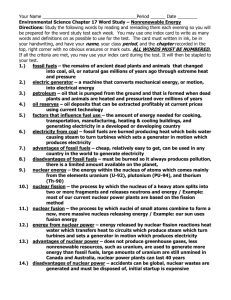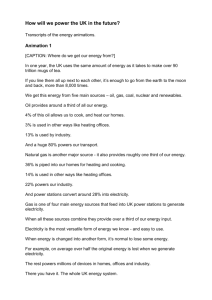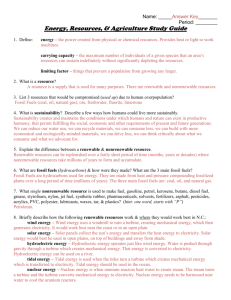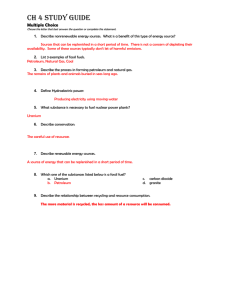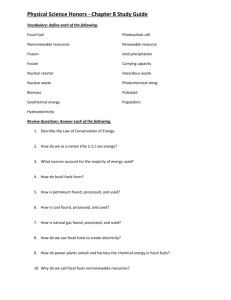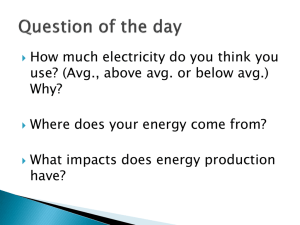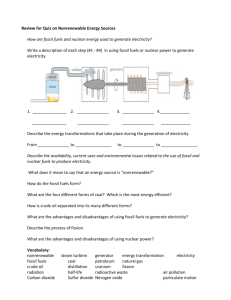Name: Study Guide for Chapter 16 Directions: Define the following
advertisement
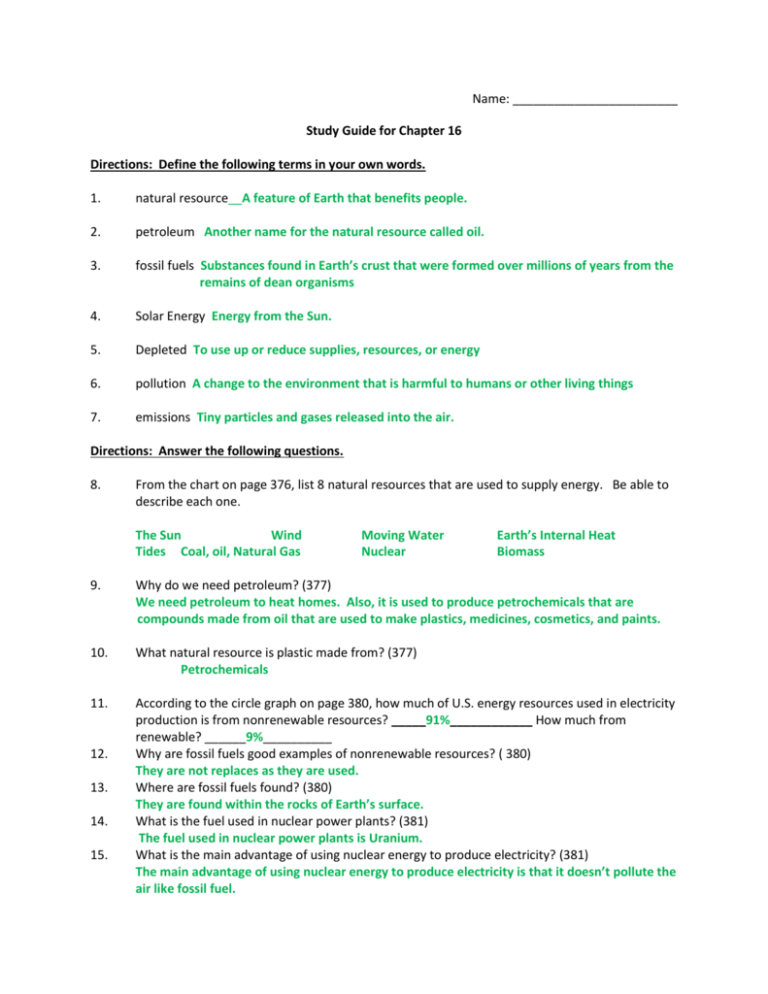
Name: ________________________ Study Guide for Chapter 16 Directions: Define the following terms in your own words. 1. natural resource__A feature of Earth that benefits people. 2. petroleum Another name for the natural resource called oil. 3. fossil fuels Substances found in Earth’s crust that were formed over millions of years from the remains of dean organisms 4. Solar Energy Energy from the Sun. 5. Depleted To use up or reduce supplies, resources, or energy 6. pollution A change to the environment that is harmful to humans or other living things 7. emissions Tiny particles and gases released into the air. Directions: Answer the following questions. 8. From the chart on page 376, list 8 natural resources that are used to supply energy. Be able to describe each one. The Sun Wind Tides Coal, oil, Natural Gas Moving Water Nuclear Earth’s Internal Heat Biomass 9. Why do we need petroleum? (377) We need petroleum to heat homes. Also, it is used to produce petrochemicals that are compounds made from oil that are used to make plastics, medicines, cosmetics, and paints. 10. What natural resource is plastic made from? (377) Petrochemicals 11. According to the circle graph on page 380, how much of U.S. energy resources used in electricity production is from nonrenewable resources? _____91%____________ How much from renewable? ______9%__________ Why are fossil fuels good examples of nonrenewable resources? ( 380) They are not replaces as they are used. Where are fossil fuels found? (380) They are found within the rocks of Earth’s surface. What is the fuel used in nuclear power plants? (381) The fuel used in nuclear power plants is Uranium. What is the main advantage of using nuclear energy to produce electricity? (381) The main advantage of using nuclear energy to produce electricity is that it doesn’t pollute the air like fossil fuel. 12. 13. 14. 15. 16. What is the main disadvantage of using nuclear energy to produce electricity? (381) The uranium fuel used stays dangerously radioactive for a long time. Also, the storage of nuclear waste. 17. What are two of the biggest challenges of using solar energy to make electricity? (382) a. A backup energy source must be used on cloudy days b. Solar energy is very spread out, so it must be collected from huge area to be a significant source of energy. 18. What are two disadvantages of using wind farms to produce electricity? (382) The wind does not always blow when electricity is needed and right now the cost of building a wind farm is greater than the cost of building a power plant that uses fossil fuel to make electricity. 19. List three renewable energy sources and write a brief description of each. (382) a. hydroelectric- use of moving water b. geothermal- hot spots near Earth’s surface c. biomass- fuels made from once living things like wood or corn. 20. What is the main energy source for operating automobiles? (384) Petroleum 21. About how many million gallons of gasoline do Americans use everyday? (384) Americans use about 375 million gallons of gasoline each day. 22. Since a bicycle is so much more efficient than automobiles, why don’t we use bicycles more often than automobiles? Bicycles aren’t as useful to us as cars. Cars take us where we want to go much faster and more conveniently than bicycles can. 23. List four ways that Earth’s air can be polluted. (387) Power plants that use fossil fuels to make electricity Motor vehicles Factories Erupting volcanoes 24. How much of Earth’s surface is water? __70%___________ How much of Earth’s water is salt water? _____97%___________ How much of Earth’s water is fresh water? ____3%____ (388) 25. List three ways Earth’s water can be polluted. (388) Wastes that are washed down sinks, toilets, and showers Industries like factories and power plants produce wastes that can pollute water. Pesticides and fertilizers from farms can end up in the water supply. Oil spills from large ships that transport oil across the oceans can cause serious pollution problems. 26. Describe global warming. (390) Global warming refers to an increase in the temperature of Earth’s climate due to increasing amounts of certain gases in the atmosphere mostly carbon dioxide. 27. What type of gas do scientists believe is most responsible for global warming? (390) Carbon Dioxide 28. If Earth’s temperature increases due to global warming, what are some possible consequences? The North Pole being warmed causing the sea level to rise 4 to 10 inches. 29. Read pages 392 and 393. What is geothermal energy? Heat that comes from inside our planet. 30 What is the difference between a regular hot spring and a geyser? Geyser is hot spring that shoots water and steam into the air. Geysers are located in areas of volcanic activity. The big difference between a hot spring and a geyser is constriction, which is narrowed area of plumbing that causes pressure to build. 31. Be prepared to answer questions about the charts on pages 396-397.


